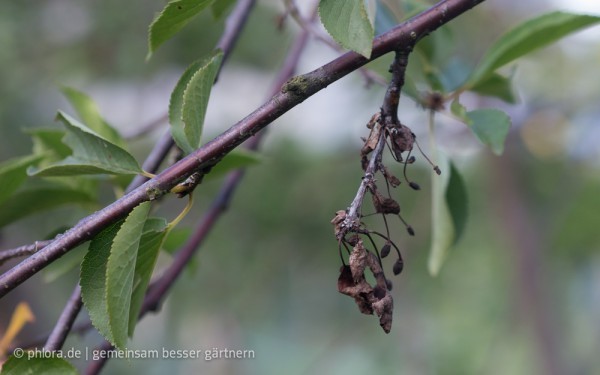Dry twigs and leaves on a cherry tree can be indicative of various issues, including environmental stress, diseases, pests, and cultural factors. It’s essential to identify the specific cause to address the problem effectively. Here are some common causes of dry twigs and leaves on a cherry tree:
- Drought Stress: Insufficient or irregular watering can lead to drought stress, causing leaves and twigs to dry out and wither. Proper irrigation, especially during dry periods, is essential.
- Root Issues: Problems with the root system, such as root rot or damage, can disrupt the tree’s ability to take up water and nutrients, leading to the drying of leaves and twigs.
- Pests: Insect infestations, such as aphids or spider mites, can damage cherry tree leaves and twigs. These pests feed on the plant’s juices, causing wilting and drying.
- Diseases: Fungal or bacterial diseases, like brown rot or bacterial canker, can infect cherry trees, causing leaves and twigs to turn brown and die. Proper sanitation and fungicidal treatments may be required.
- Nutrient Deficiencies: A lack of essential nutrients, particularly nitrogen, can result in poor foliage development and the drying of leaves. Fertilize the tree with a balanced fertilizer to address nutrient deficiencies.
- Winter Damage: Cold temperatures and winter winds can lead to desiccation of leaves and twigs. Proper winter protection and mulching can help prevent this.
- Pruning or Trimming: Over-pruning or improper pruning techniques can damage the tree, leading to the drying of branches and leaves. Prune your cherry tree following recommended guidelines.
- Environmental Factors: Extreme weather conditions, such as high winds, hail, or excessive sun exposure, can lead to the drying and damage of leaves and twigs.
- Cherry Leaf Spot: This fungal disease can cause dark spots on the leaves, which may lead to leaf drying. Fungicidal treatments and proper sanitation can help manage this issue.
- Environmental Stressors: Pollution, salt exposure, or other environmental stressors can adversely affect cherry trees, leading to leaf and twig damage.
To address the problem of dry twigs and leaves on your cherry tree, start by identifying the specific cause. Carefully inspect the tree, considering environmental factors, cultural practices, and the presence of pests or diseases. Once you’ve determined the cause, take appropriate measures to address the issue, which may include adjusting watering, pruning, applying treatments, or improving overall tree care practices. If necessary, consult with a local arborist or horticulturist for guidance and treatment options.
When the tips of the branches die on the cherry, it is an infection with the Monilia laxa pathogen. Cherry tree disease is better known as lace drought.
Most often, the infection occurs during rainy weather, during or shortly after flowering. Then the affected branches wither abruptly and hang withered on the tree until winter. “Gum flow” is often noticed at the border of healthy wood. This is a resin-like, sticky substance that oozes from the wood.
Preventive measures against drought
If infection has occurred, remove all infected branches up to 20 cm into the healthy wood. Dispose of these in the residual waste or burn the branches. Do not throw them on the compost, because the spores flying around will infect the trees again.

Then you should “thin out” the affected tree: This involves cutting off branches that are growing inward and crossing branches that are on top of each other. The aim is to let as much light and air as possible into the crown. In this way, the leaves dry more quickly and infections are unlikely to occur.
With these prophylactic measures, you will achieve that the recurrence of infestation is very low, i.e. acceptable, and you can do without the chemical mace.
When planting a new cherry, you can immediately use the resistant sour cherry varieties. The following varieties are hardly affected by Monilia: ‘Morina’, ‘Karneol’, ‘Sa- fir’, ‘Favorit’, ‘Koröser Weichsel’ and ‘Ungarische Traubige’.









